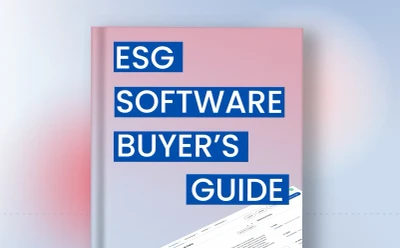
The process of selecting ESG software can be complex, especially for large enterprises with diverse reporting needs and multiple internal systems. The market is crowded, solutions can be hard to differentiate, and it's not always clear what some platforms offer beneath the surface.
At Novisto, we’ve had the privilege of seeing some of the world’s largest enterprises navigate their ESG software purchase journey. Beginning with early-stage exploration and continuing through to final vendor selection, we’ve seen how certain practices lead to a stronger product fit. This includes how teams assess internal needs and build alignment before ever engaging with a provider.
This post is part one of a two-part series and draws on insights from our ESG Software Buyer’s Guide. It outlines eight key steps to take before going too deep into the research stage—steps designed to support enterprise teams making high-stakes software investments with greater clarity and confidence.
#1. Identify and engage key stakeholders
Since ESG reporting involves multiple teams, begin by identifying the internal stakeholders who influence or depend on the software.
This can include:
- Investor Relations
- Communications and PR
- IT
- Legal
- Finance
- Product development
- Data owners
- Executive leadership
Each of these groups has different goals and concerns—take the time to understand them. What do they need the software to do? What challenges are they currently facing?
What irritates them the most?
It can also be helpful to consider who your “solution users” vs “buyers and approvers” are. We’ve included different questions to kick-start your conversation with both groups in our Buyer’s Guide.
Ultimately, gathering this input early on will help ensure that the tool you choose meets cross-functional needs, making broader buy-in across the business much more likely.
#2. Determine if you need a business case
Before going too far down the rabbit hole, check whether your organization requires a formal business case for new software. If so, you’ll need to conduct a cost-benefit analysis to ensure the vendor provides value for your investment, including a consideration of both short-term and long-term costs.
The best way to determine if this is a must-have is by consulting your internal stakeholders, particularly management and procurement. Their input will clarify whether a cost-benefit analysis is essential.
When in doubt, ask.
#3. Understand your reporting requirements
Your software needs to support the many frameworks, standards, and regulations that apply to your business. These may include:
- Voluntary frameworks such as the GRI,SASB, or TCFD
- Mandatory regulations such as the CSRD and its ESRS
- Industry-specific requirements (e.g., SFDR)
Just as important is the ability to structure and tag your ESG metrics in a way that aligns with these requirements. Some advanced platforms support a “collect once, report many” model, where ESG data can be mapped across multiple standards and frameworks, significantly reducing duplication of effort and ensuring consistency across disclosures.
It’s also worth confirming whether the platform is updated regularly to reflect changes in key ESG taxonomies. Staying current helps your organization remain aligned as expectations shift over time.
#4.Plan for future needs
Sustainability reporting is evolving quickly, and your software should be able to keep pace. That means thinking beyond immediate needs to account for your organization’s long-term ESG goals.
Will you expand to include more disclosure frameworks? Do you anticipate third-party assurance?
Will you eventually publish integrated reports?
Understanding where your sustainability strategy is headed will help you choose a platform that can support your progress, not just your current needs.
#5. Assess data location and integration.
Next, it’s important to take stock of where your ESG data currently resides. Is it stored in spreadsheets, Slacks, cloud systems, or other internal platforms?
Or, in all of the above?
Evaluate how the software will fit into your existing ecosystem. Key questions include:
- Can it integrate with enterprise systems to provide a more comprehensive view of risks?
- How will data migration be managed?
- What training will users need?
Ensuring a smooth flow of information from existing sources into the new system will reduce friction and support adoption.
#6. Match to computer literacy and language needs
The success of any software depends on how easily people can use it. For sustainability reporting, this includes contributors across functions, many of whom may not have technical roles or experience with complex data platforms.
Prioritize usability. Look for platforms that offer clean, intuitive interfaces and workflows that don’t require advanced training to navigate. A steep learning curve can slow down implementation and frustrate users, especially those who are responsible for providing critical data.
#7. Define access controls
With multiple teams engaging with ESG data, it's important to ensure that each person has access to the right level of information—no more, no less. Role-based access controls are key to managing data security, accountability, and efficiency.
A well-structured permission system typically includes:
- Contributors: Individuals inputting data
- Reviewers: Individuals validating or checking inputs
- Approvers: Individuals responsible for sign-off and oversight
This structure reduces the risk of errors, protects sensitive information, and helps keep your reporting process organized. It also reflects how real workflows happen in large organizations, where tasks are distributed across roles and departments.
When evaluating vendors, ask to see how access management is handled within the platform. Ideally, permissions should be easy to configure and flexible enough to adapt to your internal processes.
#8. Consider advisory support
Even the best software won’t replace the need for human insight. Some providers go beyond technology by offering advisory services that can support your ESG strategy and execution.
This might include:
- ESG gap assessments
- Support for ESRS readiness or other standards/frameworks
- Guidance on building double materiality assessments
If your internal team is lean or relatively new to structured ESG reporting, this support can help accelerate your progress. This is especially helpful for teams grappling with ongoing ESG reporting challenges, such as unstructured data collection and data management.
Advisory services aren’t always included by default, so be sure to ask vendors about the scope, availability, and expertise of their offerings.
Start with the right foundation
Before you demo a product or build a shortlist, take the time to clarify your organization’s needs. These early steps can make all the difference in selecting a solution that fits—not just functionally, but strategically—across teams, systems, and long-term goals.
Looking for practical guidance to support your process?
Download our ESG Software Buyer’s Guide for insights and best practices, drawn from real-world enterprise buying journeys.
